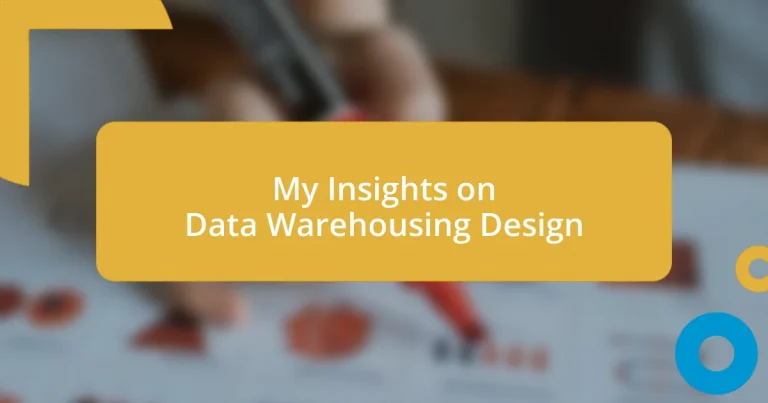Key takeaways:
- Data warehousing centralizes and organizes data, enhancing clarity and efficiency for businesses, allowing for better analysis and decision-making.
- Choosing the right data model (e.g., star schema vs. snowflake schema) is crucial and should align with business needs, scalability, and user accessibility.
- Future trends in data warehousing focus on cloud migration, integration of AI/ML for data optimization, and the necessity of real-time data processing to improve organizational responsiveness.
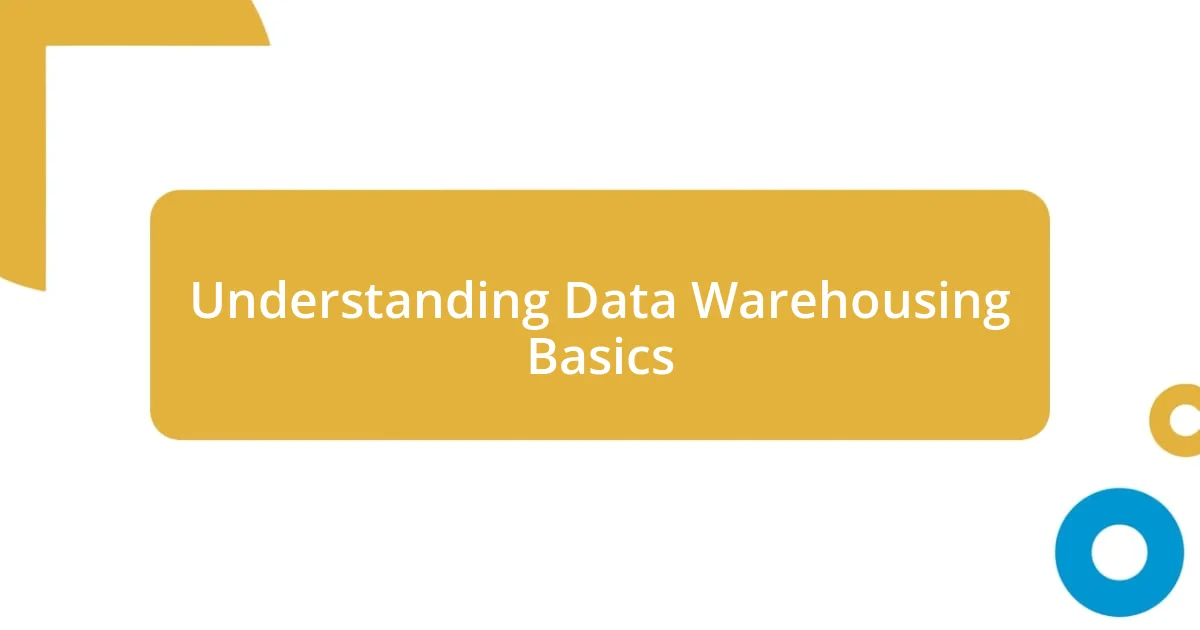
Understanding Data Warehousing Basics
Data warehousing is like creating a dedicated library for your organization’s data. Imagine you’re sorting through thousands of books every day; wouldn’t it be much easier if they were all organized and stored in one accessible place? That’s precisely what a data warehouse does—it consolidates information from various sources into a single repository to facilitate better analysis and reporting.
As I delved deeper into the concept of data warehousing, it struck me how crucial it is for businesses to have a structured approach to their data. I remember a time when I was asked to help a company struggling with data sprawl; their decision-making processes were all over the map because they lacked a cohesive data strategy. This experience reinforced my belief that having a centralized data warehouse can dramatically enhance clarity and efficiency.
Have you ever tried to find a single piece of information buried under a mountain of data? It can feel overwhelming! A well-designed data warehouse offers a robust framework—think of it as a trustworthy map through an information jungle, helping organizations draw meaningful insights and make data-driven decisions swiftly.
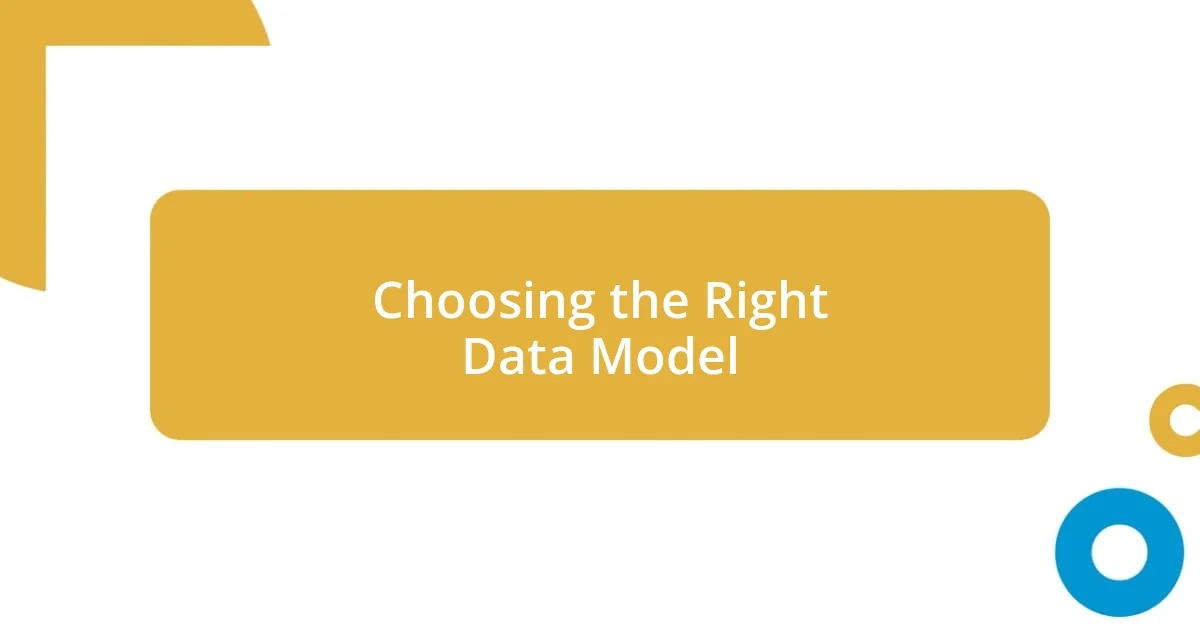
Choosing the Right Data Model
Choosing the right data model is like selecting the right foundation for a building. When I was tasked with designing a data warehouse for a start-up, I faced the challenge of choosing between a star schema and a snowflake schema. The star schema felt more intuitive; it provided straightforward access to data, which was essential for their reporting needs. The moment I saw their analysts light up when they could easily access their data was truly rewarding. Ultimately, the right model depends heavily on how your business uses data and the complexity of your relational needs.
Here are some key considerations for selecting the right data model:
- Business Requirements: Understand the specific data needs of your organization. Are you primarily focused on fast queries, or do you need more complex analyses?
- Scalability: Evaluate whether the model can adapt as your data grows. A model that works today might not suit future expansion.
- Maintenance Costs: Consider the long-term costs and resources required to maintain the data model. Some structures are easier to update than others.
- User Accessibility: The model should align with how your team consumes data. A more straightforward model might drive better user engagement.
- Data Integrity: Ensure the model preserves the accuracy and quality of data across all reports and analyses. This factor is crucial for informed decision-making.
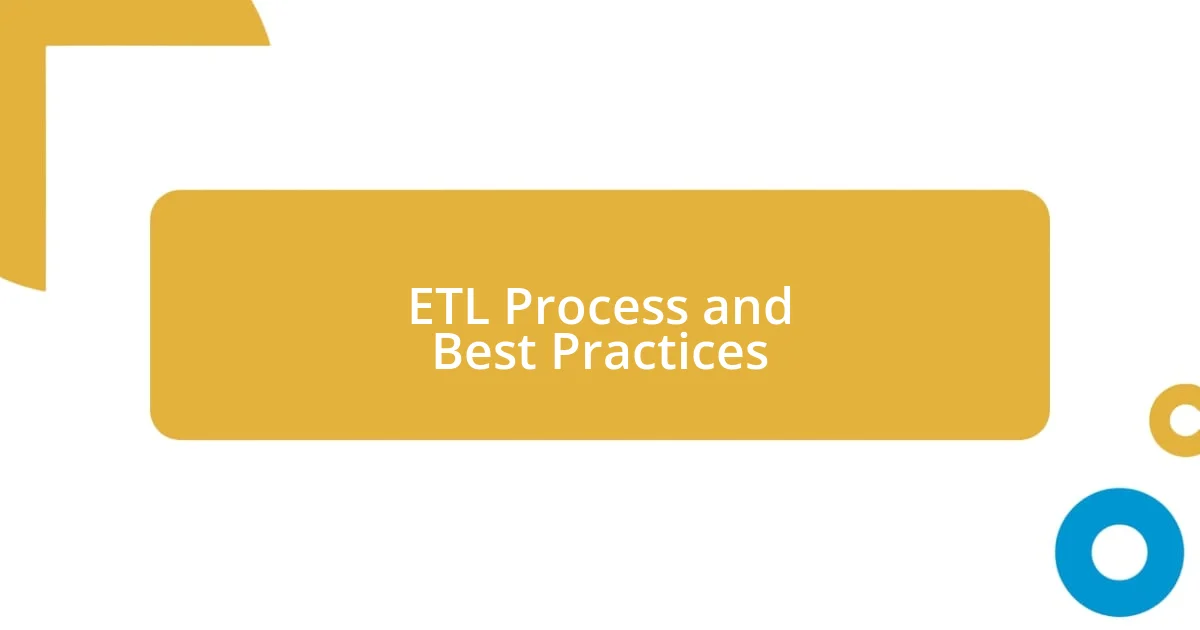
ETL Process and Best Practices
When it comes to the ETL process, I’ve always thought of it as the heartbeat of a data warehouse. Extracting, Transforming, and Loading data effectively is crucial for ensuring high data quality and reliability. I recall a project where we faced significant challenges because our ETL pipeline was poorly optimized; the delays caused frustration among the analysts who relied on timely data for their reports.
The best practices in ETL are quite straightforward but often overlooked. For instance, I emphasize the importance of documenting the ETL pipeline. This documentation not only helps future developers understand the flow of data but also serves as a valuable resource for troubleshooting. I remember on one occasion when a critical data feed broke down, and having a well-documented process enabled us to identify and fix the issue in record time.
| ETL Process Step | Best Practice |
|---|---|
| Extract | Minimize the volume of data moved—only extract what is necessary. |
| Transform | Use a staging area to cleanse and prepare data, ensuring uniformity. |
| Load | Optimize loading techniques; consider batch loading for large datasets. |
| Monitoring | Implement monitoring tools to track ETL performance and errors. |
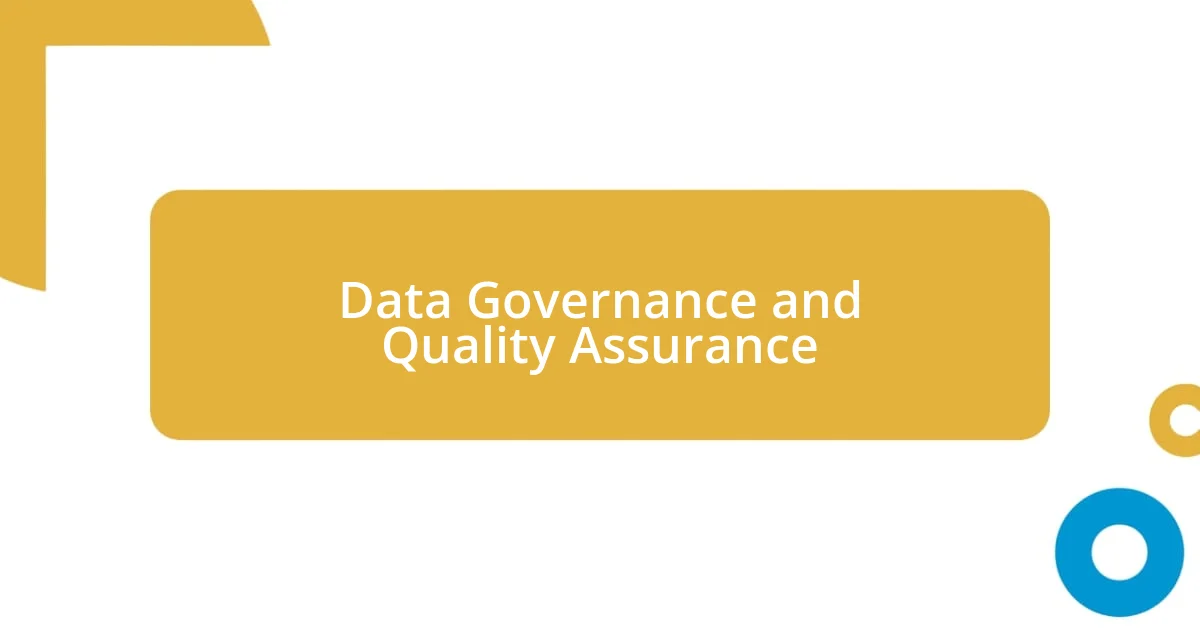
Data Governance and Quality Assurance
Ensuring data governance and quality assurance is paramount in any data warehousing project. In my experience, when I worked on a large-scale data integration effort, we implemented strict governance policies that were a game changer. The clarity and structure these measures provided helped everyone understand their roles and responsibilities, leading to more accurate data practices. Have you ever faced challenges with data accuracy in your work? I know I have, and incorporating governance protocols was a step towards rebuilding that trust in our data.
Quality assurance goes beyond just checking for errors; it’s about fostering a culture of continuous improvement. During one of my projects, we instituted routine quality checks that not only identified inconsistencies but also engaged the team in discussions about best practices. This collaborative approach not only elevated the quality of our data but also boosted team morale, as everyone felt they had a stake in the outcome. How often do you involve your team in data quality discussions? I find that the more inclusive you are, the better the results.
Ultimately, data governance and quality assurance are intertwined; one cannot truly exist without the other. I recall a scenario where a lack of governance led to data discrepancies that sparked conflict between departments. It took a lot of time and effort to resolve those issues, but it was a vital lesson learned. By prioritizing both governance and quality assurance from the get-go, you can pave the way for smoother operations and a reliable data warehouse. Isn’t it fascinating how a little extra time spent on these elements upfront can save so much hassle later on?
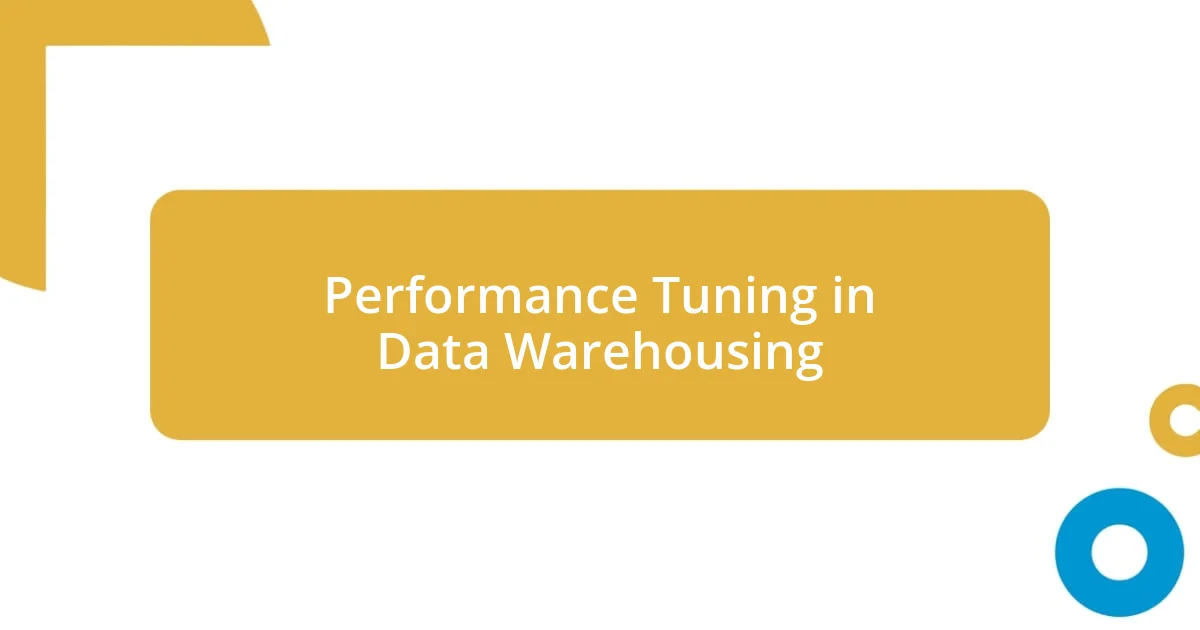
Performance Tuning in Data Warehousing
Performance tuning in data warehousing is truly an art form. I vividly remember a project where we struggled with slow query speeds, causing frustration among the stakeholders waiting for data insights. By analyzing execution plans and indexing strategies, we discovered that small adjustments could lead to performance gains. It’s amazing what a little fine-tuning can achieve, don’t you think?
One of the most effective strategies I found involves partitioning large tables. During a particularly data-heavy deployment, we implemented partitioning based on date ranges, which drastically improved our query performance. It’s like having a neatly organized filing cabinet instead of a chaotic pile of papers. Have you ever experienced the chaos of unoptimized data? Once I grasped the benefits of partitioning, it changed my approach entirely.
I also believe in continuous monitoring and adjustment. After a recent tuning effort, I set up alerts to track query performance over time. When a query began to slow down, I could promptly dig in and adjust before it became a bigger issue. I often wonder how many teams neglect this critical step, only to find themselves in a reactive mode instead of staying ahead of potential bottlenecks. Wouldn’t you agree that proactive measures create a smoother workflow?
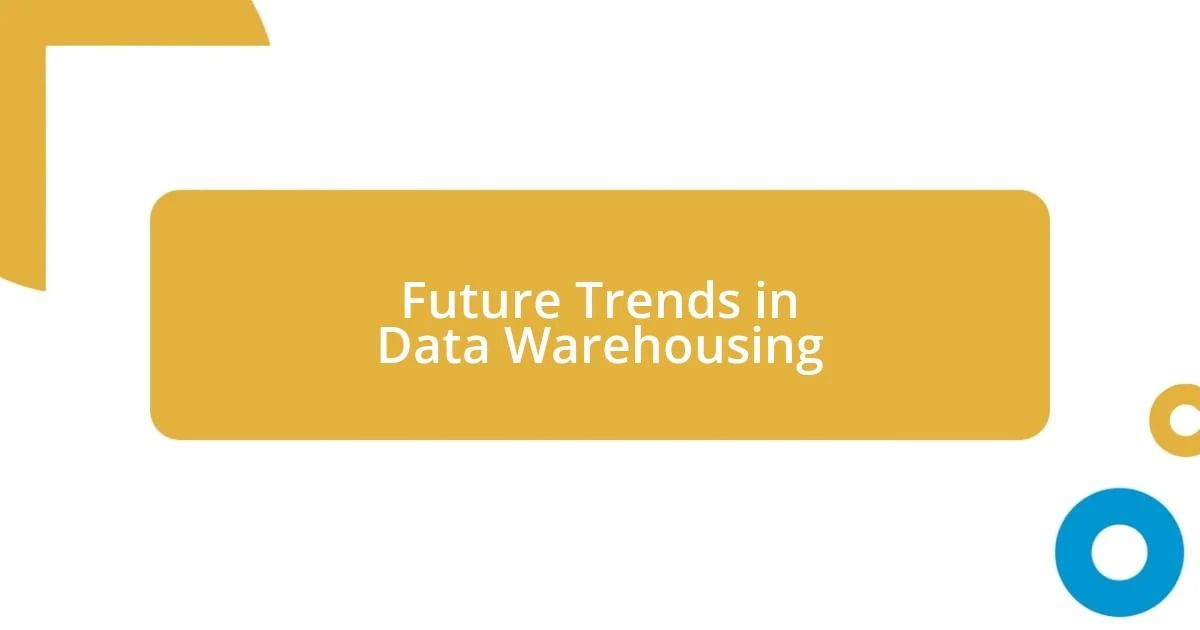
Future Trends in Data Warehousing
The future of data warehousing is undoubtedly leaning towards the cloud. I’ve seen firsthand how companies are migrating their systems to cloud platforms, which not only enhance scalability but also reduce infrastructure costs. Can you imagine the freedom in managing a data warehouse without the physical constraints of on-premise systems? It’s like shedding heavy baggage just to run faster.
Another trend that excites me is the integration of artificial intelligence and machine learning in data warehousing. On one of my recent projects, we implemented machine learning algorithms to optimize data retrieval and analysis. It was fascinating to watch the system learn from usage patterns, evolving to become more efficient over time. Have you ever thought about how automation can transform the manual processes in data management? The potential here is immense, enabling teams to focus on strategic initiatives rather than routine data handling.
Lastly, real-time data processing is becoming a necessity rather than a luxury. I remember working on a project where timely data insights were crucial for decision-making. Transitioning to a real-time data architecture not only improved responsiveness but also empowered the business to act quickly on emerging trends. It’s incredibly satisfying to see organizations leverage immediate data, isn’t it? As we move forward, I truly believe that the evolution in data warehousing will be driven by these innovative technologies, reshaping how we create, manage, and utilize our data landscapes.












